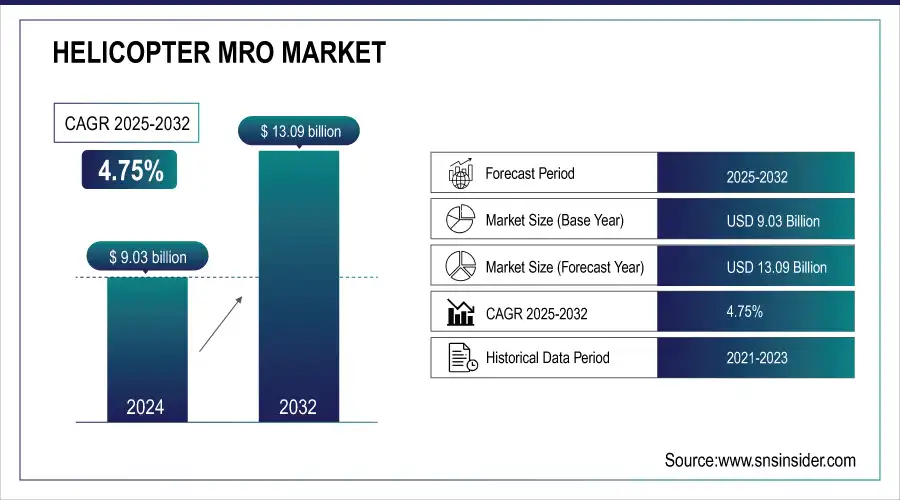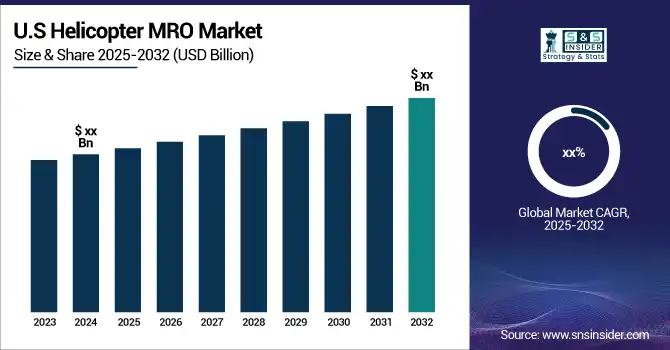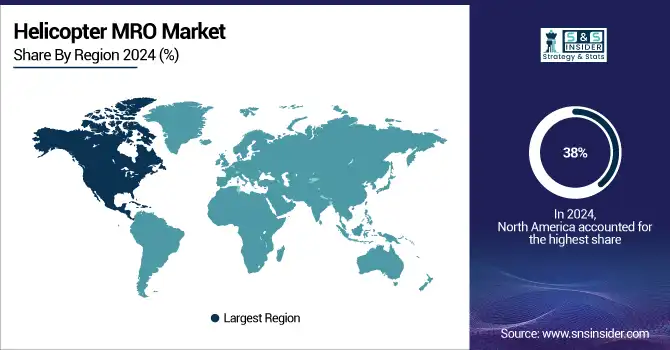Helicopter MRO Market Report Scope & Overview:
The Helicopter MRO Market Size was valued at USD 9.03 billion in 2024 and is expected to reach USD 13.09 billion by 2032 with an emerging CAGR of 4.75% over the forecast period 2025-2032.

To get more information on Helicopter MRO Market - Request Free Sample Report
Helicopters are essential for distant access, intra-city travel, police enforcement, disaster relief, search and rescue, and emergency medical evacuation. Aircraft maintenance, repair, and overhaul (MRO) has become an essential component for ensuring proper servicing, airworthiness, and customer protection for a fleet. MRO companies do maintenance, evaluations, and regular and overhaul checks. Aircraft use, worldwide fleet size, and air traffic level all have an impact on the global civil helicopter MRO industry. National and international aviation regulatory organisations closely monitor operators and OEMs in the industry to guarantee compliance with severe regulations and procedures. The helicopter MRO market has been steadily expanding in recent years and is likely to expand further in the coming years.

Helicopter MRO Market Size and Forecast:
-
Market Size in 2024: USD 9.03 Billion
-
Market Size by 2032: USD 13.09 Billion
-
CAGR: 4.75% from 2025 to 2032
-
Base Year: 2024
-
Forecast Period: 2025–2032
-
Historical Data: 2021–2023
Key Helicopter MRO Market Trends:
-
Advancement of predictive maintenance technologies, leveraging IoT sensors, AI, and digital twins, enables early fault detection, reduces downtime, and extends helicopter lifecycle performance.
-
Adoption of Health Usage Monitoring Systems (HUMS) supports real-time data collection, predictive analytics, and more efficient maintenance scheduling for both civil and military fleets.
-
Integration of 3D printing and additive manufacturing accelerates on-demand production of spare parts, minimizes supply chain delays, and lowers overall maintenance costs.
-
Use of augmented reality (AR), virtual training, and remote inspection tools enhances technician efficiency, reduces human error, and addresses global shortages of skilled MRO personnel.
-
Rising demand from emergency medical services (EMS), law enforcement, and firefighting sectors drives continuous helicopter fleet utilization and creates steady aftermarket service requirements.
-
Expansion of military helicopter MRO, driven by fleet modernization and lifecycle extension programs, sustains long-term demand for engine, avionics, and structural upgrades.
-
Growing focus on eco-friendly and sustainable MRO practices, including green cleaning, energy-efficient hangars, and waste reduction, aligns with global environmental regulations.
Helicopter MRO Market Drivers:
-
Rising Demand for Commercial Helicopters Fuels Market Expansion
The increase in the use of commercial helicopters is a key factor driving growth in the aviation and maintenance sectors. Commercial helicopters are widely deployed across diverse industries, including emergency medical services (EMS), law enforcement, offshore oil and gas operations, tourism, and corporate transportation. Their ability to provide rapid, point-to-point connectivity in congested urban areas or remote locations makes them a valuable alternative to traditional modes of transport. The expansion of sectors such as air ambulance services and disaster relief has further amplified demand, particularly as governments and private operators prioritize rapid response capabilities. Additionally, growing interest in urban air mobility and the development of advanced rotorcraft technologies are broadening the role of helicopters in passenger and cargo transportation. This rising utilization not only boosts helicopter sales but also creates sustained demand for maintenance, repair, and overhaul (MRO) services, ensuring safety, operational efficiency, and extended fleet availability worldwide.
Helicopter MRO Market Restraints:
-
Hazards to the Environment in the Helicopter MRO Market
The helicopter MRO market, while critical for safety and operational efficiency, poses several environmental hazards. Maintenance activities generate hazardous waste such as lubricants, solvents, and chemical cleaners that can contaminate soil and water if not managed properly. Aircraft painting and coating processes release volatile organic compounds (VOCs), contributing to air pollution and health risks. Additionally, the high energy consumption of MRO facilities increases carbon emissions, adding to the industry’s environmental footprint. Noise pollution from engine testing and rotor checks can also disrupt surrounding communities and ecosystems. With increasing global emphasis on sustainability, operators are under pressure to adopt eco-friendly practices, including waste recycling, green cleaning technologies, and energy-efficient hangars, to reduce these environmental impacts.
Helicopter MRO Market Opportunities:
-
Increase in 3D Printing of Helicopter MRO Components
The adoption of 3D printing in helicopter MRO is rapidly transforming the industry by enabling faster, cost-effective, and more flexible production of components. Traditional supply chains for critical parts often face delays and high costs, especially for legacy or specialized helicopters. With additive manufacturing, operators can produce lightweight, durable components such as brackets, housings, and non-structural parts on demand, significantly reducing lead times and inventory requirements. This technology also allows for customization, improved material efficiency, and reduced waste, aligning with sustainability goals. For military and remote operations, 3D printing ensures critical parts are available closer to the point of use, minimizing downtime and enhancing fleet readiness, making it a key enabler of modern helicopter maintenance practices.
Helicopter MRO Market Segmentation Analysis:
By Application, the Military Segment Dominates Revenue, the Civil Segment Exhibits Fastest Growth
The Military segment dominated with the largest revenue share of 53% in 2024. This is driven by defense modernization programs, rising global security concerns, and the extension of service life for aging fleets. Military helicopters require intensive maintenance cycles for engines, avionics, and structural upgrades, resulting in high expenditure on MRO services. As governments prioritize operational readiness and invest heavily in product upgrades, the helicopter MRO market gains consistent demand from long-term defense contracts worldwide. The Civil segment is growing at the largest CAGR of 13.71% during the forecast period. This growth stems from rising demand for helicopters in emergency medical services, law enforcement, firefighting, and corporate transport. Expanding civil fleets increase the need for regular line and component maintenance to ensure safety and compliance with aviation standards. Product innovations in light and medium helicopters further accelerate civil adoption, creating significant opportunities for MRO providers to deliver specialized and cost-efficient services.

By Helicopter Type, Medium Helicopters Lead Market Share While Light Helicopters Drive Rapid Growth
The Medium Helicopter segment dominated the market with the largest revenue share of 47% in 2024. This dominance is due to their versatile role in military operations, offshore oil and gas transport, and search-and-rescue missions, which require robust performance and reliability. As fleet utilization rises, demand for maintenance services such as engine overhauls and airframe checks grows proportionally. Consequently, the helicopter MRO market benefits from higher recurring service contracts, ensuring stable revenue streams and ongoing product development initiatives. The Light Helicopter segment is growing at the largest CAGR of 13.66% during the forecast period. The surge is driven by expanding use in civil applications such as air ambulance services, tourism, and corporate transport, where affordability and agility are essential. Increasing production of advanced light helicopters results in a larger installed base requiring frequent line and component maintenance. This directly fuels MRO demand, as operators seek cost-effective, efficient servicing solutions, boosting overall market growth.
By Type, Engine Maintenance Commands Revenue, Component Maintenance Shows Highest CAGR
The Engine Maintenance segment dominated the market with the largest revenue share of 47% in 2024. Helicopter engines endure high operational stress, requiring frequent overhauls and replacements to maintain airworthiness. The increase in fleet utilization across both civil and military sectors amplifies demand for engine servicing. As manufacturers develop more fuel-efficient and complex engines, MRO providers are compelled to expand capabilities, making engine maintenance the backbone of the helicopter MRO market’s revenue generation. The Component Maintenance segment is growing at the fastest CAGR during the forecast period. The rise is driven by the need to service critical systems such as avionics, rotor blades, and landing gear, which are increasingly sophisticated due to technological advancements. Frequent replacement cycles and higher integration of electronic systems in modern helicopters accelerate component-level servicing requirements. This trend directly supports the helicopter MRO market, as operators depend on specialized providers to maintain safety, efficiency, and mission readiness.
Helicopter MRO Market Regional Analysis:
North America Dominates Helicopter MRO Market in 2024
North America holds an estimated 38% market share in 2024, driven by large civil and military helicopter fleets, high defense spending, and advanced MRO infrastructure. This causes operators to prioritize regular engine, airframe, and component maintenance, ensuring fleet reliability, operational readiness, and compliance with aviation standards, thereby sustaining steady revenue growth for MRO providers.

Need any customization research on Helicopter MRO Market - Enquiry Now
-
United States Leads North America’s Helicopter MRO Market
The U.S. dominates due to extensive military and civil helicopter operations, including EMS, law enforcement, offshore transport, and corporate aviation. Federal defense programs, fleet modernization, and stringent safety regulations increase recurring maintenance demand. OEMs and independent MRO providers offer advanced services, from engine overhauls to avionics upgrades, ensuring efficiency and safety. Strong R&D, regulatory support, and high fleet utilization make the U.S. the largest contributor to North America’s helicopter MRO leadership.
Asia Pacific is the Fastest-Growing Region in Helicopter MRO Market in 2024
The region is expected to grow at a CAGR of 12.8% from 2025–2032, driven by expanding civil and military helicopter fleets and rising adoption in EMS, offshore, and corporate transport. This causes operators to invest in predictive maintenance, component replacement, and engine servicing to ensure operational efficiency and safety.
-
China Leads Asia Pacific’s Helicopter MRO Market
China dominates the Asia Pacific market due to rapid fleet expansion and adoption of helicopters across civil and military sectors. National investments in local MRO facilities and partnerships with OEMs reduce turnaround times, supporting higher operational availability. Urban air mobility initiatives, emergency services, and offshore operations further increase maintenance demand. Technological advancements and fleet modernization programs ensure China drives regional helicopter MRO growth.
Europe Helicopter MRO Market Insights, 2024
Europe maintains a significant share of the market, supported by mature defense fleets, civil helicopter adoption, and strict safety regulations. Germany’s defense modernization, civil fleet expansion, and regulatory emphasis cause increased demand for maintenance, repair, and overhaul services across Europe.
-
Germany Leads Europe’s Helicopter MRO Market
Germany dominates due to its large military fleet, high civil helicopter utilization, and strong regulatory enforcement. Investments in advanced MRO facilities, predictive maintenance systems, and component servicing support operational readiness. Collaboration between OEMs, service providers, and regulatory authorities ensures fleet safety and efficiency, reinforcing Germany’s leadership in the European helicopter MRO sector.
Middle East & Africa and Latin America Helicopter MRO Market Insights, 2024
The Helicopter MRO Market in these regions is expanding steadily, supported by growing demand from oil and gas, emergency services, and tourism. Countries such as the UAE and Saudi Arabia invest heavily in modern helicopters and MRO infrastructure, while Brazil and Mexico focus on fleet maintenance for offshore, medical, and law enforcement operations. Partnerships with OEMs and regional service providers enhance maintenance efficiency, while rising fleet utilization drives consistent demand for engine, component, and line maintenance services across both regions.
Competitive landscape for the Helicopter MRO Market:
Lockheed Martin Corporation
Lockheed Martin Corporation is a U.S.-based global leader in aerospace, defense, and advanced helicopter technologies. The company provides comprehensive helicopter MRO services, including engine overhauls, airframe maintenance, avionics upgrades, and lifecycle support for military and government fleets. Lockheed Martin integrates cutting-edge diagnostic tools, predictive maintenance technologies, and OEM-certified parts to ensure high operational readiness and reliability. Its role in the helicopter MRO market is pivotal, supporting long-term defense contracts and enhancing mission-critical capabilities for rotary-wing aircraft worldwide.
-
In 2025, Lockheed Martin expanded its MRO portfolio by introducing advanced predictive maintenance solutions for Sikorsky and Black Hawk helicopter fleets, increasing uptime and fleet availability.
Airbus Helicopters
Airbus Helicopters, a European multinational, is a leading manufacturer and service provider for civil and military helicopters. The company offers end-to-end MRO solutions, including component repair, engine servicing, structural inspections, and upgrade programs, supporting both new and legacy fleets. Airbus Helicopters plays a central role in the global helicopter MRO market by providing certified, high-quality maintenance services that maximize safety, efficiency, and operational performance.
-
In 2025, Airbus Helicopters launched a comprehensive upgrade program for H145 and H225 fleets, integrating digital monitoring systems and advanced component maintenance services to enhance fleet longevity and operational efficiency.
Boeing Company
Boeing Company is a U.S.-based aerospace and defense giant offering extensive helicopter MRO services for both commercial and military operators. The company specializes in airframe heavy maintenance, engine overhauls, avionics upgrades, and integrated support solutions. Boeing’s MRO offerings leverage advanced diagnostics, predictive analytics, and OEM-approved parts, ensuring fleet reliability and compliance with regulatory standards. Its role in the helicopter MRO market is significant, supporting global fleets and enhancing readiness for critical missions.
-
In 2025, Boeing introduced an optimized MRO program for CH-47 Chinook and AH-64 Apache helicopters, incorporating AI-assisted maintenance tracking and rapid component replacement solutions.
Leonardo S.p.A.
Leonardo S.p.A., headquartered in Italy, is a leading global helicopter manufacturer and MRO service provider. The company delivers comprehensive maintenance, repair, and overhaul solutions, including engine servicing, component maintenance, airframe inspections, and avionics upgrades for civil and military helicopters. Leonardo strengthens the helicopter MRO market by offering tailored, end-to-end support services that improve fleet reliability, reduce downtime, and enhance operational performance.
-
In 2025, Leonardo expanded its MRO capabilities by launching a new service center in Europe, focusing on advanced diagnostics, predictive maintenance, and rapid component replacement for AW139 and AW169 fleets.
Helicopter MRO Market Key Players:
-
Lockheed Martin Corporation
-
Airbus Helicopters
-
Boeing Company
-
Sikorsky Aircraft Corporation (a Lockheed Martin Company)
-
Leonardo S.p.A.
-
Bell Textron Inc.
-
Russian Helicopters
-
ST Engineering Aerospace Ltd
-
Heli-One
-
StandardAero
-
MTU Aero Engines AG
-
Honeywell Aerospace
-
Rolls-Royce Holdings plc
-
GE Aviation
-
L3Harris Technologies
-
Airwork Group
-
CAE Inc.
-
Lufthansa Technik AG
-
Babcock International Group
-
Russian Helicopters Maintenance Center
| Report Attributes | Details |
|---|---|
| Market Size in 2024 | US$ 9.03 Billion |
| Market Size by 2032 | US$ 13.09 Billion |
| CAGR | CAGR of 4.75% From 2025 to 2032 |
| Base Year | 2024 |
| Forecast Period | 2025-2032 |
| Historical Data | 2021-2023 |
| Report Scope & Coverage | Market Size, Segments Analysis, Competitive Landscape, Regional Analysis, DROC & SWOT Analysis, Forecast Outlook |
| Key Segments | • By Helicopter Type (Light Helicopter (<3>9.0 Tons)) • By Application (Civil and Military) • By Type (Airframe Heavy Maintenance, Engine Maintenance, Component Maintenance and Line Maintenance) |
| Regional Analysis/Coverage | North America (US, Canada, Mexico), Europe (Eastern Europe [Poland, Romania, Hungary, Turkey, Rest of Eastern Europe] Western Europe] Germany, France, UK, Italy, Spain, Netherlands, Switzerland, Austria, Rest of Western Europe]), Asia Pacific (China, India, Japan, South Korea, Vietnam, Singapore, Australia, Rest of Asia Pacific), Middle East & Africa (Middle East [UAE, Egypt, Saudi Arabia, Qatar, Rest of Middle East], Africa [Nigeria, South Africa, Rest of Africa], Latin America (Brazil, Argentina, Colombia, Rest of Latin America) |
| Company Profiles | Honeywell International Inc., Leonardo SpA, Safran SA, StandardAero, Textron Inc, United Technologies Corporation, Airbus SAS, Heli-One, MTU Aero Engines AG, Rolls-Royce Holdings PLC |

